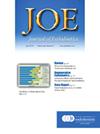低温处理和温次氯酸钠对有症状不可逆牙髓炎牙齿术后疼痛的影响:随机对照试验。
IF 3.5
2区 医学
Q1 DENTISTRY, ORAL SURGERY & MEDICINE
引用次数: 0
摘要
简介:本研究旨在评估低温处理和温次氯酸钠(NaOCl)对症状性不可逆牙髓炎和症状性根尖牙周炎患者术后疼痛的影响:根据AAE指南,66名下颌磨牙患者术前疼痛评分在Heft Parker视觉模拟疼痛量表(HP-VAS)上≥54mm,被诊断为症状性不可逆牙髓炎和症状性根尖牙周炎。按照标准方案准备通路和根管,并对其进行器械检查和灌洗。根据最终灌洗液的温度,根管被随机分为三组,分别灌洗 3% NaOCl:对照组(25°C)、冷 NaOCl 组(2°C)和温 NaOCl 组(60°C)(n = 22/组)。根管治疗在同一次就诊中完成。使用 HP-VAS 对术前和术后 6、24、48 和 72 小时的疼痛进行评估,并记录镇痛剂的用量。数据分析采用了适当的统计检验:结果:与其他两组相比,冷 NaOCl 组在所有随访时间段的 HP-VAS 评分都较低。各组之间在 6 小时和 72 小时的术后疼痛评分差异有统计学意义(P < 0.05)。对照组和冷 NaOCl 组的受试者在术后 72 小时内均无任何不适感:结论:与室温和温热 NaOCl 相比,使用冷 NaOCl 作为最终冲洗剂的患者在 6 小时后的术后疼痛明显减轻。本文章由计算机程序翻译,如有差异,请以英文原文为准。
Impact of Cryotreated and Warm Sodium Hypochlorite on Postoperative Pain in Teeth With Symptomatic Irreversible Pulpitis: A Randomized Controlled Trial
Introduction
The purpose of this study was to evaluate effect of cryotreated and warm sodium hypochlorite (NaOCl) on postoperative pain in patients with symptomatic irreversible pulpitis and symptomatic apical periodontitis.
Methods
Sixty-six individuals with preoperative pain scores of ≥54 mm on the Heft Parker Visual Analogue Pain Scale (HP-VAS) diagnosed with symptomatic irreversible pulpitis and symptomatic apical periodontitis as per the American Association of Endodontists guidelines in mandibular molars were included. The preparation of the access and the root canals was instrumented and irrigated in accordance with a standard protocol. Based on the temperature of the final irrigant, the root canals were then randomly assigned to 3 groups and 3% NaOCl was irrigated: control (at 25°C), cold NaOCl (2°C), and warm NaOCl (60°C) (n = 22/group). Root canal treatment was completed at the same visit. Pre- and postoperative pain assessment at 6, 24, 48, and 72 hours was conducted using the HP-VAS, and analgesic consumption was noted. Suitable statistical tests were used to analyze the data.
Results
In comparison with the other 2 groups, the cold NaOCl group had a lower HP-VAS score at all follow-up intervals. Between groups, there was a statistically significant difference in postoperative pain scores at 6 and 72 hours (P < .05). None of the subjects experienced any postoperative discomfort at 72 hours in the control and cold NaOCl groups.
Conclusion
Patients treated with cold NaOCl as the final irrigant experienced significantly less postoperative pain at 6 hours when compared with room temperature and warm NaOCl.
求助全文
通过发布文献求助,成功后即可免费获取论文全文。
去求助
来源期刊

Journal of endodontics
医学-牙科与口腔外科
CiteScore
8.80
自引率
9.50%
发文量
224
审稿时长
42 days
期刊介绍:
The Journal of Endodontics, the official journal of the American Association of Endodontists, publishes scientific articles, case reports and comparison studies evaluating materials and methods of pulp conservation and endodontic treatment. Endodontists and general dentists can learn about new concepts in root canal treatment and the latest advances in techniques and instrumentation in the one journal that helps them keep pace with rapid changes in this field.
 求助内容:
求助内容: 应助结果提醒方式:
应助结果提醒方式:


